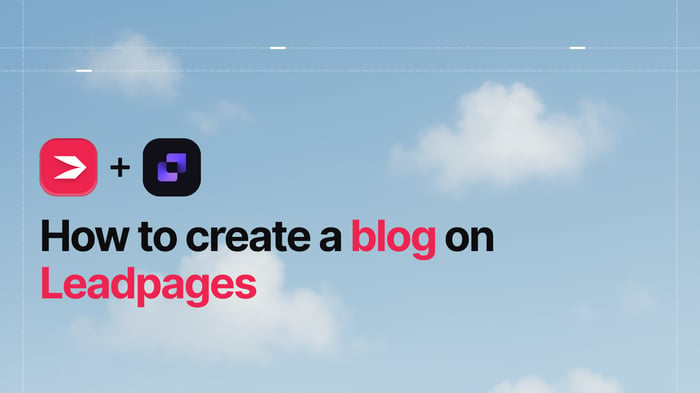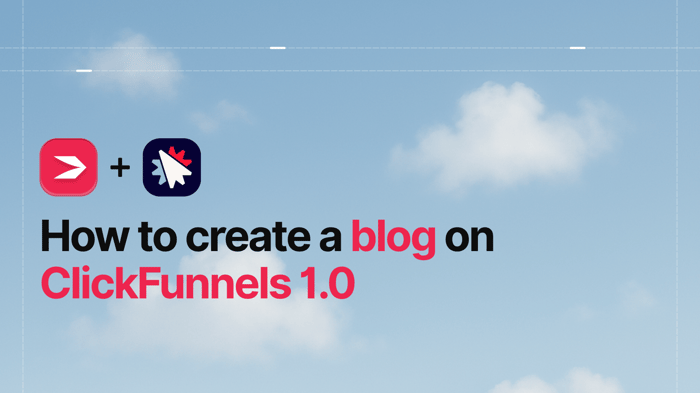ClickFunnels was created by marketers for marketers and online business people. It’s most certainly not a standard site builder and it’s not an eCommerce platform like Shopify, although it includes certain aspects of both.
So, what is it? Simply put, ClickFunnels is a sales funnel builder. It’s intended to be simple and easy to use. It integrates with many third-party apps.
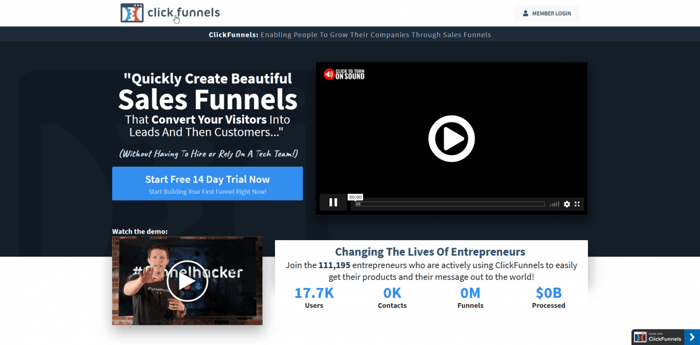
Leadpages is also not a standard site builder or an eCommerce platform. It’s neither an all-in-one sales and marketing platform nor a sales funnel builder. It’s a platform that’s used primarily for landing pages, lead generation, and lead conversion.
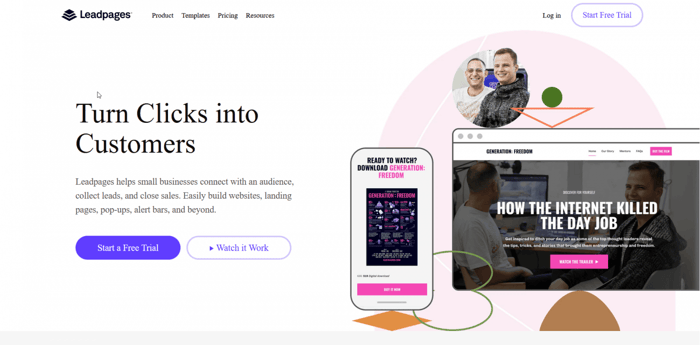
If they’re so different, then how can we compare them? You’ll see in the next few sections.
Table of Contents
What Do ClickFunnels and Leadpages Have in Common?
Leadpages is all about creating pages or building sites aimed at attracting more visitors, collecting their email addresses, and turning more of them into customers, thus helping people grow their businesses.
Its landing pages contain nothing distracting. Their goal is to call for action: signing up, leaving personal information that can later be used for marketing purposes, and the like. Even the home page of a Leadpages website should be viewed as a landing page. The Leadpages website pages and websites are appealing, but simple and optimized for conversion.
ClickFunnels was created as much more than that. It’s a platform that’s meant to give you all the necessary tools to cover the entire process that’s referred to by the term “sales funnel”. As you may already know, it’s a multistage process that consists of:
- Finding a way to raise users’ awareness about your product/service (advertising, affiliates, commercials, etc);
- Making users want to get to know more about what you offer so they begin to search actively for more detailed information;
- Persuading them to try out your product/service;
- Assuring users that what you offer is valuable, so they become customers and decide to purchase from you;
- Finding a way to keep your customers satisfied and loyal (emails, special offers, good customer support, etc).

The term “sales funnel” is just a metaphor for a series of actions you take, based on an elaborated sales and marketing strategy, to sell your products or services. It covers everything from advertising to selling. That’s what ClickFunnels was created for.
Considering that the goal of a landing page is to make a user interested in what you offer, which should lead to a purchase, Leadpages covers only part of the whole sales funnel path. As far as ClickFunnels is concerned with landing pages, lead generation, and lead conversion, it has a lot in common with Leadpages. And that is what gives us the right to put them side by side and make a ClickFunnels vs Leadpages comparison.
Once we start talking about things that go beyond that, I don’t think it’s fair to compare Leadpages to ClickFunnels, let alone complain how Leadpages doesn’t provide all the types of tools found in ClickFunnels.
It doesn’t because it’s not a one-stop sales funnel builder like ClickFunnels. Leadpages has specialized in providing a couple of services, and that’s how it is to be evaluated: whether it does what it’s supposed to be doing... not whether it lacks what it isn’t even supposed to provide in the first place.
Since we’ve cleared that up, let’s proceed to the next section where I’ll explore the pricing systems of both platforms and compare the value-for-money ratios.
Pricing
ClickFunnels
ClickFunnels doesn't offer a free plan, but that’s not a surprise, considering that it lets you build an entire sales funnel. However, it offers a 14-day free trial to test-drive its features.
There are 3 ClickFunnels pricing plans:
1. The cheapest plan is called simply ClickFunnels and it costs $97/month.
It lets you build a maximum of 20 funnels that you can share with others. As to creating pages, more precisely, sub-pages within a funnel, you can have up to 100 of them.
This plan also allows you to collaborate with a team member by letting you add 1 sub-user.
You can process payments through 3 payment gateways, connect to 3 domains, and get access to FunnelFlix, where you can watch courses from experts in the field. Last, but not least, for those rainy days we all have, you can count on the ClickFunnels chat support.
2. The next in line is Platinum. The price of this plan is $297/month.
It allows you to build unlimited pages, funnels, and follow-up funnels (a chance to "contact your audience, even after they leave your funnel" via email). You can have 3 sub-users, even more training and courses, weekly peer review hackathons that include coaching guidance, and use 9 payment processors and domains. With this plan, you’re entitled to priority support.
3. The most expensive ClickFunnels plan is called Two Comma Club X and it’s worth $2,497/month.
There’s almost nothing that this pricing plan provides that you can’t get with the Platinum plan. The difference is scale. So, you get 10 sub-users (instead of 3), 27 payment processors and domains, and additional special training and courses. The only big difference is the VIP phone support.
Obviously, ClickFunnels is not cheap. In this context, one of the things reviewers complain about is that you only get access to such a basic tool like automated email service (part of the follow-up funnels) starting with the Platinum plan. It looks like this plan is the ClickFunnels personal favorite, which implies that the company considers it to be the best value for the money and the most recommended option for the bulk of online businesses. Still, it’s a lot of money to pay for adding such an elementary feature to your assortment of tools.
Leadpages
Leadpages also offers a 14-day trial period and three paid plans.
Let’s have a look at the pricing plans:
1. The cheapest Leadpages plan is the Standard plan. The price is $37/month if you’re billed on a monthly basis or $27/month if you decide to pay a yearly subscription.
It allows you to create landing pages, pop-ups, alert bars, and 1 website. Security and hosting are also well taken care of in the form of SSL certificates, fast page loads, and reliable hosting (Google App Engine). With the annual subscription, you get a custom domain; the same goes for the following 2 plans as well.
With the Standard plan, your pages and sites are optimized to handle high traffic and big numbers of leads. You also get access to 40+ standard integrations and tons of customizable responsive templates. On top of that, you can have as many leads as you want - there’s no cap here whatsoever.
2. The second Leadpages plan is the Pro plan. It costs $79/month (monthly) or $59 (yearly).
It includes many features found in the Standard plan.
Of course, there are some differences. One of them is that it lets you build 3 sites. Another extremely important difference is that it allows you to make online sales and payments (via Stripe). In addition to this, you get unlimited A/B split testing, 10 opt-in text campaigns, and email trigger links.
3. The third plan is called Advanced. It’s the most expensive plan: $321/month (monthly) or $239/month (yearly).
With it, you can build 50 sites, add advanced integrations, make use of 50 opt-in text campaigns, and work with a team thanks to the available 5 Pro sub-accounts. Along with this, you’re entitled to a 1-on-1 quick start call with a Leadpages specialist whose job it is to get you started as smoothly as possible.
Obviously, judging solely from the prices of the plans, Leadpages is much cheaper than ClickFunnels. The general agreement on Leadpages pricing is that it’s a good value for the money.
However, if you’re willing to pay for the Advanced plan, then it’s probably better to go with a platform that offers more in terms of sales and marketing tools.
Customer Support
ClickFunnels
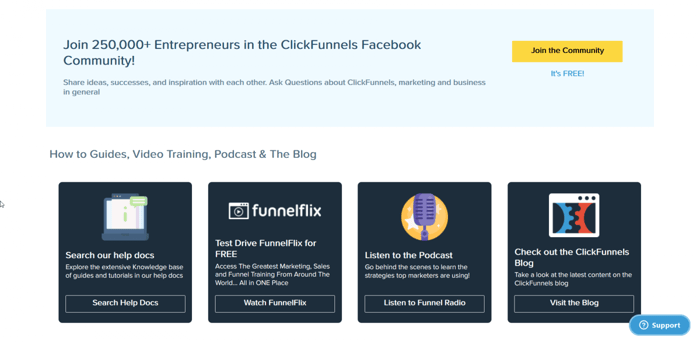
ClickFunnels shows it cares for its customers in various ways:
- Documentation, where there are numerous how-to guides, podcasts, courses, and more;
- Blog, where you can find tons of articles on important sales and marketing topics;
- Official Facebook Group, a place where members of the ClickFunnels community can share their thoughts and experiences related to the platform;
- Support Chat, available to all members from 8 a.m. to 8 p.m. (EST), Monday-Friday.
Most of the reviewers have good things to say about the ClickFunnels support service. However, on TrustPilot, you can find some pretty harsh criticism too. Overall, I’d say the support offered is good, but it’s not ClickFunnels’ strongest side.
Leadpages
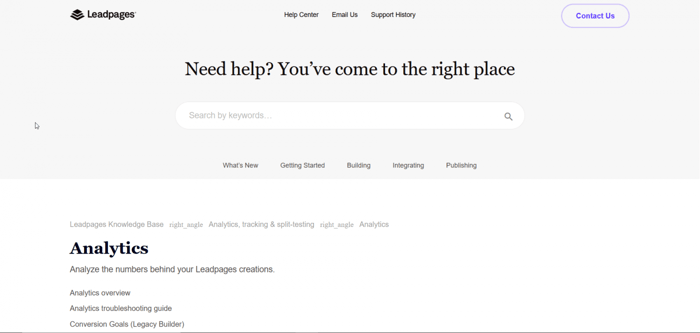
Leadpages too provides customer support via different channels:
- Help Center page, where there are various useful links that lead to a host of articles on different subjects related to the platform;
- Contact Form, that any visitor can fill out to contact the Leadpages support staff via email;
- Besides email support, Leadpages offers chat support with the Pro plan and priority support by phone with the Advanced plan.
Even though Leadpages doesn’t provide chat support for all customers, the general consensus of users and reviewers is that Leadpages offers excellent customer service. It’s probably due to the fact that the staff is very friendly, extremely helpful, professional, and proactive.
Software and Customization
ClickFunnels
There’s so much about ClickFunnels that’s ambiguous.
On one side, there are users who’d swear on ClickFunnels. On the other side, there are those who assert that it’s clunky, buggy, bloated, slow (especially page load time), full of glitches, and that the features it offers are, to put it mildly, not that good compared to what other platforms of a similar type offer. Some say that, for example, its membership sites are great while others say the exact opposite. You get the idea.
ClickFunnels is meant to be a one-stop platform for building sales funnels. All-in-one platforms can be very good because they offer everything in one place, which makes them very convenient. On the flip side, there’s usually a trade-off. When there are so many things in one place, often not everything works that well. Especially when the bulk of the software is not developed by the platform’s team, but instead it’s more of a duct-taped collection of different, even disparate, pieces of software. Besides this, one-stop platforms usually have one or a couple of things that work well, at the expense of everything else. So, you might end up paying too much for a mediocre product, in this case, software.
However, this doesn’t mean that’s always the case. Here what separates a good from a bad all-in-one platform would be the following: if a sufficient number of tools work well and you can make good use of them, you could say it’s worthwhile to use that platform.
When it comes to ClickFunnels, the best thing about it is definitely the affiliate program. This is something that a big majority of reviewers would agree upon.
The page templates are just okay. The problem is that they look very alike and the choices are pretty limited as far as customization is concerned. Aesthetically speaking, they do not fare very well, although that’s subjective. Functionality-wise, they’re pretty good.
The page builder is easy to use and the process of creating a landing page or any other type of page, for that matter, is simple. Thanks to its drag-and-drop interface, you can easily make quick changes and publish your page.
Leadpages
Leadpages doesn’t provide nearly as many tools as ClickFunnels, but it integrates with a host of amazing 3rd-party apps. Say you want to blog, you can integrate Leadpages with DropInBlog and start blogging in no time.
With Leadpages, you can build a landing page from scratch, but it’s really the templates where this platform shines. There are hundreds of templates and they’re all responsive, customizable, and aesthetically pleasing. You can choose a template based on whether you’re creating a landing page, squeeze page, sales page, 404 page, or a website. There are also different templates for different industries: wellness, e-books, education, real estate, food, and more.
But the best thing about the Leadpages templates is that the platform gives you an opportunity to pick templates that are proven to be high-converting. This is possible thanks to the collected data on how well the Leadpages templates perform in practice. Those with higher conversion rates are higher on the list. You can even search for the highest-converting templates. On top of this, Leadpages rates your page before publishing, enabling you to tweak it so it performs well in the context of lead generation and lead conversion.
Leadpages also offers a drag-and-drop interface that enables you to customize pages very easily. You can’t do wonders, but there’s plenty of room for experimentation with the pre-given designs. You can play with navigation, colors, images, fonts, and layouts. Additionally, you can modify the padding and margin of elements as well as sections on your page. You don’t need coding skills for this, but if you do know how to code and your page/site requires advanced customization, then you have your hands untied to experiment with HTML, CSS, and JavaScript.
The page/site builder does a relatively good job, but it’s not as flexible as you’d want it to be. For instance, you can’t move around and place widgets anywhere you want on the page. It’s because they reside within the boundaries of a section, so they can’t move outside of it.
One cool feature of Leadpages is that it provides an option to duplicate and hide sections, which is very helpful when you do split testing. You can test variations of your page without deleting anything. Just duplicate or hide certain parts on one version of the page and wait to see which one converts better. If necessary, you can do additional adjustments.
Leadpages also offers customizable pop-ups and alert bars, which are extremely useful conversion tools.
Final Thoughts
So what can we say at the end of this ClickFunnels vs Leadpages comparison?
From its inception, Leadpages has been all about lead generation and lead conversion, and it has built a great reputation for its high-converting landing pages. It’s cheaper than ClickFunnels, but it lacks many features found there.
However, this doesn’t have to be a disadvantage at all. Leadpages doesn’t advertise as an all-in-one sales and marketing platform or a complete sales funnel builder, so it would work best as part of a varied assemblage of pieces of software that do specialized jobs, like Webflow for a website, DropInBlog for a blog, Leadpages for lead generation and conversion, etc.
ClickFunnels may be a revelatory experience, or it may make you feel like you’re at your wits’ end. It offers many features, but it’s pricey. You can do more with it than with Leadpages, but the “more” part comes at the expense of quality and speed. It’s best suited for someone who, besides page creation, lead generation, and lead conversion, wants a really good affiliate system.
Switching from one platform to another could be a big problem and, in the experience of many who’ve already been there, it can cause a lot of headaches. That’s why we hope this article provided you with enough information to choose wisely.


